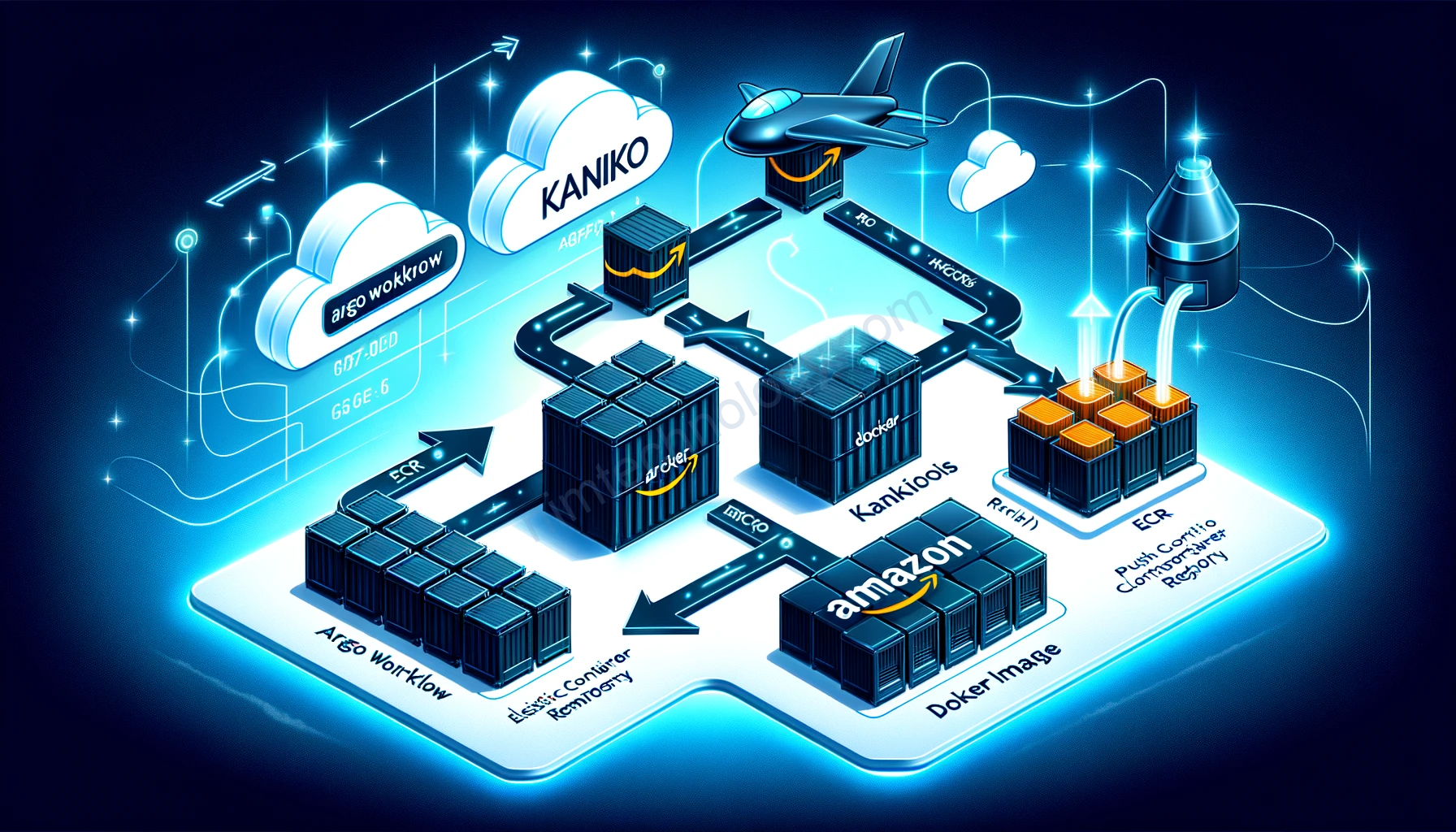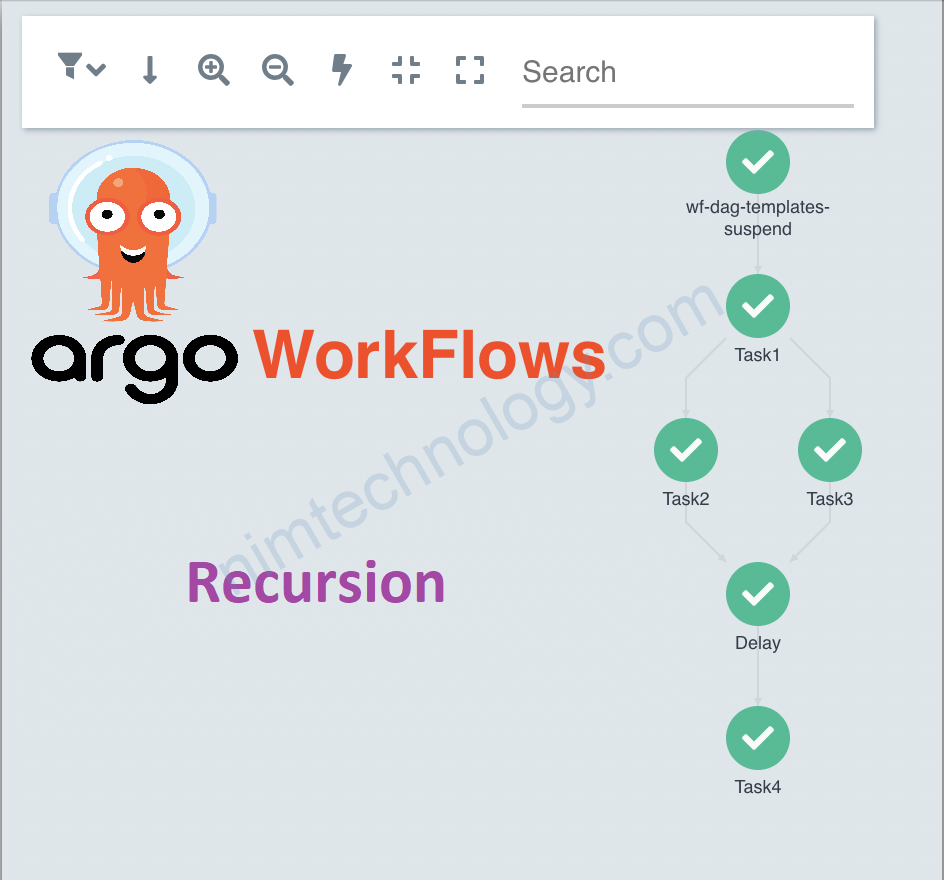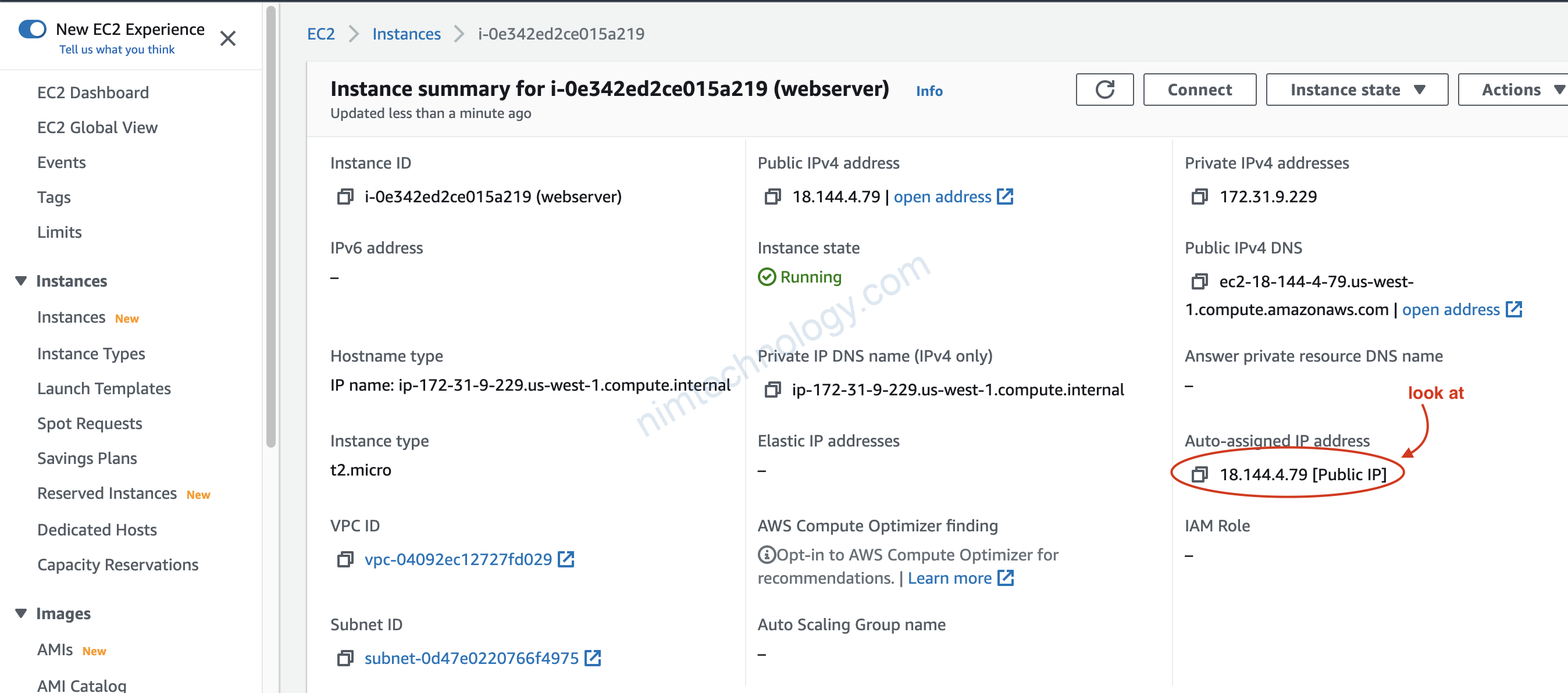chúng ta có rất nhiều tool để CI: jenkin, github action, bitbucket, pipelie
Hôm này chúng ta sẽ chọn Argo Workflow để build 1 solution để CI cho team.
Nó sẽ chạy trong internal K8s cluster.
trước khi làm được bài này thì mình có tham khảo các links:
https://medium.com/@mrsirsh/a-simple-argo-workflow-to-build-and-push-ecr-docker-images-in-parallel-a4fa67d4cd60
https://mikenabhan.com/posts/build-docker-image-argo-workflows/
Sau đây sẽ là Full configuration và sau đó chúng ta sẽ mổ sẻ từng phần.
apiVersion: argoproj.io/v1alpha1
kind: WorkflowTemplate
metadata:
name: integration-template
spec:
entrypoint: integration
volumeClaimTemplates:
- metadata:
name: workdir
spec:
accessModes:
- ReadWriteOnce
resources:
requests:
storage: 500Mi
storageClassName: ebs-gp3-workflow-sc
arguments:
parameters:
- name: git-branch
value: "feature/XXXX1-475"
- name: integration-command
value: "node index.js -e staging -a integration"
templates:
- name: integration
inputs:
parameters:
- name: git-branch
- name: integration-command
dag:
tasks:
- name: git-clone
template: git-clone
arguments:
parameters:
- name: git_branch
value: '{{inputs.parameters.git-branch}}'
- name: ls
template: ls
dependencies:
- git-clone
- name: build
template: build
dependencies:
- git-clone
- ls
- name: run-integration
template: run-integration
arguments:
parameters:
- name: integration_command
value: '{{inputs.parameters.integration-command}}'
dependencies:
- build
- name: trivy-image-scan
template: trivy-image-scan
dependencies:
- build
- name: trivy-filesystem-scan
template: trivy-filesystem-scan
dependencies:
- git-clone
- name: git-clone
nodeSelector:
kubernetes.io/os: linux
inputs:
parameters:
- name: git_branch
artifacts:
- name: argo-source
path: /src
git:
repo: https://bitbucket.org/XXXX/et-XXXX-engines.git
singleBranch: true
branch: "{{inputs.parameters.git_branch}}"
usernameSecret:
name: git-creds
key: username
passwordSecret:
name: git-creds
key: password
container:
image: alpine:3.17
command:
- sh
- -c
args:
- |
apk add --no-cache rsync
rsync -av /src/ .
workingDir: /workdir
volumeMounts:
- name: workdir
mountPath: /workdir
- name: ls
container:
image: alpine:3.17
command:
- sh
- -c
args:
- ls -la /workdir
workingDir: /workdir
volumeMounts:
- name: workdir
mountPath: /workdir
- name: build
container:
image: gcr.io/kaniko-project/executor:latest
args:
- --context=/workdir/tools
- --dockerfile=integration_test/docker/Dockerfile
- --destination=XXXXXXXXXXXX.dkr.ecr.us-west-2.amazonaws.com/integration_testing:{{workflow.name}}
- --tar-path=/workdir/.tar
workingDir: /workdir
volumeMounts:
- name: workdir
mountPath: /workdir
- name: run-integration
inputs:
parameters:
- name: integration_command
container:
image: XXXXXXXXXXXX.dkr.ecr.us-west-2.amazonaws.com/integration_testing:{{workflow.name}}
command:
- sh
- -c
args:
- |
{{inputs.parameters.integration_command}}
workingDir: /app
envFrom:
- secretRef:
name: integration-env
- name: trivy-image-scan
container:
image: aquasec/trivy
args:
- image
- XXXXXXXXXXXX.dkr.ecr.us-west-2.amazonaws.com/integration_testing:{{workflow.name}}
- name: trivy-filesystem-scan
container:
image: aquasec/trivy
args:
- filesystem
- /workdir
- --ignorefile=/workdir/.tar
workingDir: /workdir
volumeMounts:
- name: workdir
mountPath: /workdir
1) Create a Persistent Volume for running Pipeline
1.1) Overview.

Bạn có thể thấy là đôi khi trong pipeline của bạn cần save file hay code xuống 1 volume và bạn muốn duy trì volume đó trong suốt quá trình run pipeline cho đến khi kết thúc.
Như hình sau khi mình pull code về thì mình muốn save nó xuống disk và sử dụng cho build step tiếp theo như: build and test.

Bạn sẽ hỏi là ủa! trên 1 pipeline: chạy step này tới step kia mắc gì lưu disk rồi tạo volume?
Nó là chạy các step trên cùng 1 con mà?
No! No!
Nếu nhìn kĩ config thì bạn sẽ thấy ở mỗi step chúng ta đang run docker image khác nhau => mỗi step là 1
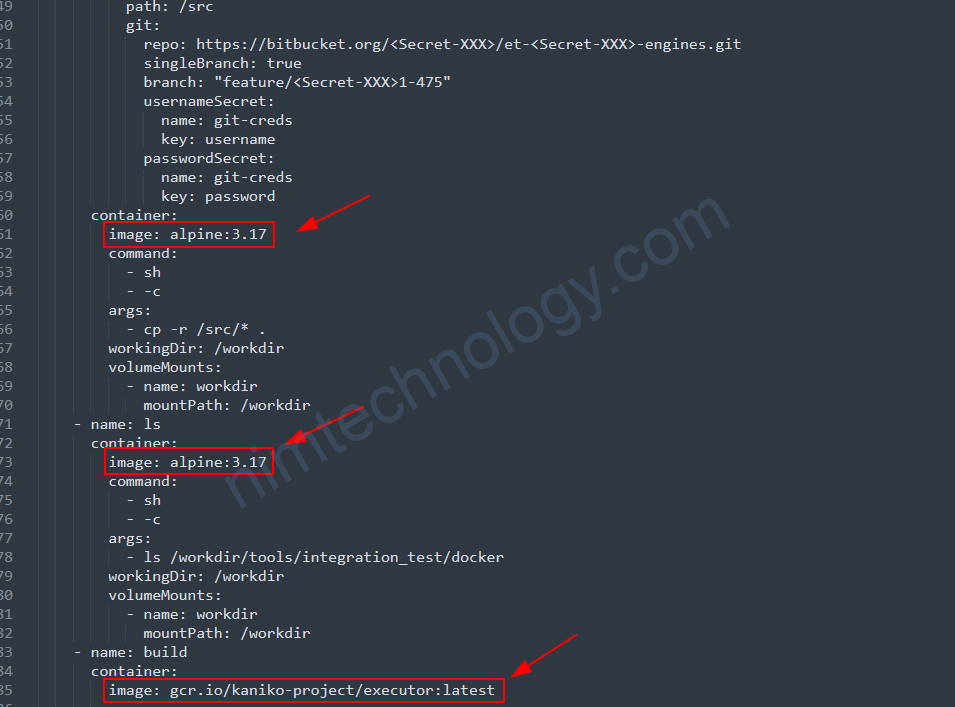
pod và chúng ta cần mount pv vào các pod đó.
OK!

1.2) Look into configurations
volumeClaimTemplates:
- metadata:
name: workdir
spec:
accessModes:
- ReadWriteOnce
resources:
requests:
storage: 500Mi
storageClassName: ebs-gp3-sc
Understanding volumeClaimTemplates
Purpose: This template is used to create a PVC for each instance of the workflow. It allows workflows to have a dedicated, temporary storage that is created when the workflow starts and can be disposed of when the workflow completes.
metadata.name: The name of the PVC that will be created. In your case, it’sworkdir.spec.accessModes: Defines how the PVC can be accessed.ReadWriteOncemeans the volume can be mounted as read-write by a single node.spec.resources.requests.storage: The amount of storage requested. Here, it’s 500 MiB.spec.storageClassName: The StorageClass to be used for provisioning the volume.ebs-gp3-scindicates an AWS EBS volume with gp3 type will be provisioned.
1.3) Workflow Integration
In your WorkflowTemplate, the volumeClaimTemplates section defines a PVC named workdir that will be created for each workflow run. This PVC is then used by various steps in your workflow, such as git-clone, ls, build, and run-integration. Each of these steps mounts the workdir volume, allowing them to share data and files between them.
For instance, in the git-clone step:
volumeMounts:
- name: workdir
mountPath: /workdir
This snippet mounts the workdir PVC at the /workdir path in the container. This pattern is repeated in other steps, ensuring that they all operate on the same set of data.
1.4) Considerations
- Storage Limits: Be mindful of the storage size and class you specify, as they should meet the requirements of your workflow.
- Clean Up: Depending on your cluster configuration, you might need to clean up the PVCs after workflow completion to avoid leftover volumes consuming resources.
Đi sâu vào vấn đề clean up thi bạn nên tạo 1 storage class với config như sau:
allowVolumeExpansion: true apiVersion: storage.k8s.io/v1 kind: StorageClass metadata: name: ebs-gp3-workflow-sc parameters: encrypted: 'true' iops: '3000' throughput: '125' type: gp3 provisioner: ebs.csi.aws.com reclaimPolicy: Delete volumeBindingMode: WaitForFirstConsumer
In this case, reclaimPolicy: Delete means that any PVs dynamically provisioned using this StorageClass will have their persistentVolumeReclaimPolicy set to Delete.
2) Use the Dag template to control the pipeline process in the argo workflow.
Phần này thì bạn sẽ thấy câu trả lời Dag template là gì:
https://nimtechnology.com/2022/01/04/argoworkflows-lesson2-demo-steps-template-and-dag-template-on-argoworkflows/#DAG_Template
apiVersion: argoproj.io/v1alpha1
kind: WorkflowTemplate
metadata:
name: integration-template
spec:
entrypoint: integration
### hide code #####
templates:
- name: integration
dag:
tasks:
- name: git-clone
template: git-clone
- name: ls
template: ls
dependencies:
- git-clone
- name: build
template: build
dependencies:
- git-clone
- ls
- name: run-integration
template: run-integration
dependencies:
- build
In the context of an Argo Workflow, the entrypoint field specifies the first template that is executed when a workflow starts. It acts as the starting point of your workflow. In your provided configuration, the entrypoint is set to integration
How entrypoint Works in Your Workflow:
- Template
integration: In your workflow, theintegrationtemplate is the starting point. This template defines a DAG (Directed Acyclic Graph) which orchestrates the execution order of different tasks. - DAG in
integrationTemplate:- The
integrationtemplate contains a series of tasks (git-clone,ls,build,run-integration), each of which refers to another template in thetemplatessection. - These tasks are executed according to the dependencies defined. For example,
lsandbuilddepend ongit-clone. This meansgit-clonemust complete beforelsandbuildstart. Similarly,run-integrationdepends onbuild.
- The
- Flow of Execution:
- When the workflow is initiated, Argo starts with the
integrationtemplate because it’s specified as theentrypoint. - Within
integration, the tasks are executed following the DAG’s logic, ensuring the right order and dependencies are maintained.
- When the workflow is initiated, Argo starts with the
3) Child Tasks in a series
3.1) Git Clone in Argo Workflow.
- name: git-clone
nodeSelector:
kubernetes.io/os: linux
inputs:
artifacts:
- name: argo-source
path: /src
git:
repo: https://bitbucket.org/<Secret-XXX>/et-<Secret-XXX>-engines.git
singleBranch: true
branch: "feature/<Secret-XXX>1-475"
usernameSecret:
name: git-creds
key: username
passwordSecret:
name: git-creds
key: password
container:
image: alpine:3.17
command:
- sh
- -c
args:
- cp -r /src/* .
workingDir: /workdir
volumeMounts:
- name: workdir
mountPath: /workdir
Đầu tiên mình thích git clone code về với branch “feature/1-475”
để làm được điều này thì bạn phải config singleBranch: true
vì đây là private git: cần có credentials để login:
usernameSecret:
name: git-creds
key: username
passwordSecret:
name: git-creds
key: password
Sau khi git clone code xong thì mình sử dụng container: alpine:3.17
để copy code vào folder:
Các error trong argo workflow: /workdir
3.2) Build image docker and push it to ECR by Kaniko.
ECR mà mình sử dụng nó là 1 private hub.
nên bạn sẽ cần config Kaniko authen with ECR
https://github.com/GoogleContainerTools/kaniko?tab=readme-ov-file#pushing-to-amazon-ecr
Kaniko họ sử dụng cái The Amazon ECR credential helper để authen với ECR AWS.
với K8s thì có 2 cách.
3.2.1) use file credentials.
Nghĩa là bạn cần tạo 1 secret:
kubectl create secret generic aws-secret --from-file=<path to .aws/credentials> File credentials có format như sau:
[default] aws_access_key_id = YOUR_ACCESS_KEY_ID aws_secret_access_key = YOUR_SECRET_ACCESS_KEY
Tiếp đến là bạn mount chúng step kaniko
apiVersion: v1
kind: Pod
metadata:
name: kaniko
spec:
containers:
- name: kaniko
image: gcr.io/kaniko-project/executor:latest
args:
- "--dockerfile=<path to Dockerfile within the build context>"
- "--context=s3://<bucket name>/<path to .tar.gz>"
- "--destination=<aws_account_id.dkr.ecr.region.amazonaws.com/my-repository:my-tag>"
volumeMounts:
# when not using instance role
- name: aws-secret
mountPath: /root/.aws/
restartPolicy: Never
volumes:
# when not using instance role
- name: aws-secret
secret:
secretName: aws-secret
3.2.2) use IRSA.
Vì mình đã setup argo workflow authen AWS vi IRSA:
https://nimtechnology.com/2023/04/17/argo-workflows-lesson23-setup-logging-and-artifact-repository/#21_AWS_S3_IRSA
nên mình chỉ cần update Policy IAM là xong:
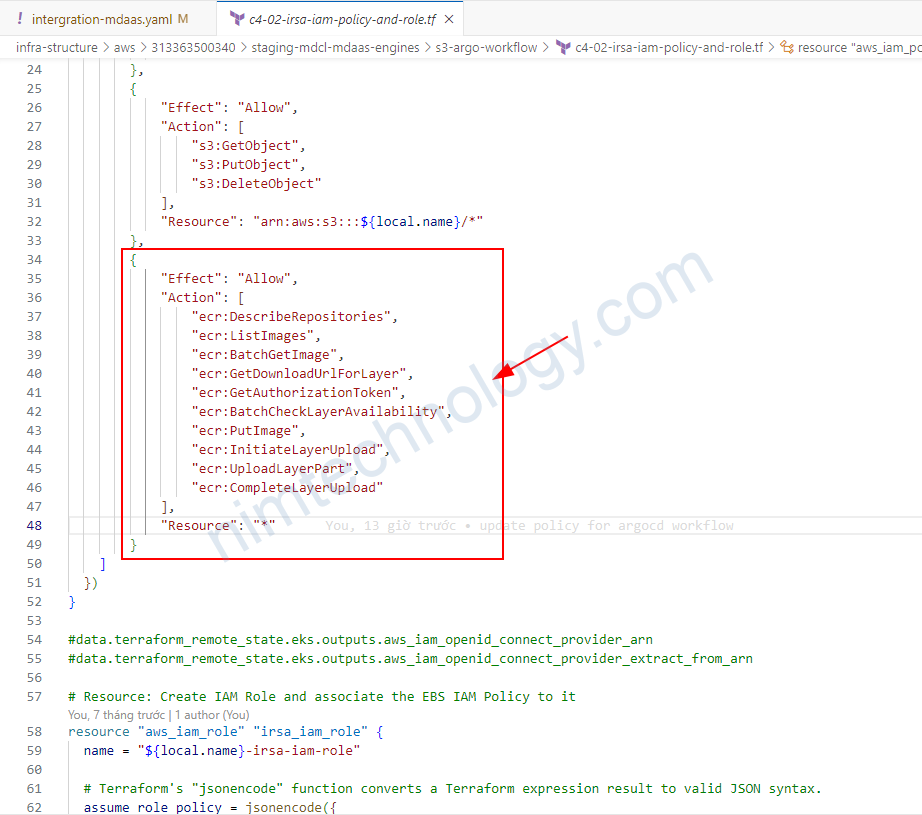
# output "aws_iam_openid_connect_provider_arn" {
# description = "aws_iam_openid_connect_provider_arn"
# value = "arn:aws:iam::${element(split(":", "${data.aws_eks_cluster.k8s.arn}"), 4)}:oidc-provider/${element(split("//", "${data.aws_eks_cluster.k8s.identity[0].oidc[0].issuer}"), 1)}"
# }
# Resource: IAM Policy for Cluster Autoscaler
resource "aws_iam_policy" "irsa_iam_policy" {
name = "${local.name}-ArgoWorkflowPolicy"
path = "/"
description = "Argo Workflow Policy"
# Terraform's "jsonencode" function converts a
# Terraform expression result to valid JSON syntax.
policy = jsonencode({
"Version": "2012-10-17",
"Statement": [
{
"Effect": "Allow",
"Action": [
"s3:ListBucket",
"s3:GetBucketLocation"
],
"Resource": "arn:aws:s3:::${local.name}"
},
{
"Effect": "Allow",
"Action": [
"s3:GetObject",
"s3:PutObject",
"s3:DeleteObject"
],
"Resource": "arn:aws:s3:::${local.name}/*"
},
{
"Effect": "Allow",
"Action": [
"ecr:DescribeRepositories",
"ecr:ListImages",
"ecr:BatchGetImage",
"ecr:GetDownloadUrlForLayer",
"ecr:GetAuthorizationToken",
"ecr:BatchCheckLayerAvailability",
"ecr:PutImage",
"ecr:InitiateLayerUpload",
"ecr:UploadLayerPart",
"ecr:CompleteLayerUpload"
],
"Resource": "*"
}
]
})
}
#data.terraform_remote_state.eks.outputs.aws_iam_openid_connect_provider_arn
#data.terraform_remote_state.eks.outputs.aws_iam_openid_connect_provider_extract_from_arn
# Resource: Create IAM Role and associate the EBS IAM Policy to it
resource "aws_iam_role" "irsa_iam_role" {
name = "${local.name}-irsa-iam-role"
# Terraform's "jsonencode" function converts a Terraform expression result to valid JSON syntax.
assume_role_policy = jsonencode({
Version = "2012-10-17"
Statement = [
{
Action = "sts:AssumeRoleWithWebIdentity"
Effect = "Allow"
Sid = ""
Principal = {
Federated = "arn:aws:iam::${element(split(":", "${data.aws_eks_cluster.k8s.arn}"), 4)}:oidc-provider/${element(split("//", "${data.aws_eks_cluster.k8s.identity[0].oidc[0].issuer}"), 1)}"
}
Condition = {
StringLike = {
"${element(split("oidc-provider/", "arn:aws:iam::${element(split(":", "${data.aws_eks_cluster.k8s.arn}"), 4)}:oidc-provider/${element(split("//", "${data.aws_eks_cluster.k8s.identity[0].oidc[0].issuer}"), 1)}"), 1)}:sub": "system:serviceaccount:argo-workflow:argoworkflow-<Secret-XXX>-staging-argo-workflows-*"
}
}
},
]
})
tags = {
tag-key = "${local.name}-irsa-iam-role"
}
}
# Associate IAM Role and Policy
resource "aws_iam_role_policy_attachment" "irsa_iam_role_policy_attach" {
policy_arn = aws_iam_policy.irsa_iam_policy.arn
role = aws_iam_role.irsa_iam_role.name
}
output "irsa_iam_role_arn" {
description = "IRSA Demo IAM Role ARN"
value = aws_iam_role.irsa_iam_role.arn
}
3.2.3) Configuration task.
- name: build
container:
image: gcr.io/kaniko-project/executor:latest
args:
- --context=/workdir/tools
- --dockerfile=integration_test/docker/Dockerfile
- --destination=<Secret-XXX>.dkr.ecr.us-west-2.amazonaws.com/integration_testing:{{workflow.name}}
workingDir: /workdir
volumeMounts:
- name: workdir
mountPath: /workdir
Bạn có thể link bên dưới để hiều về: “–context” và “–dockerfile”
https://nimtechnology.com/2021/06/06/huong-dan-build-image-docker-chay-trong-container/#Build_image_docker_with_Kaniko_and_Argo_Workflow
level=warning msg="failed to patch task set, falling back to legacy/insecure pod patch, see https://argoproj.github.io/argo-workflows/workflow-rbac/" error="workflowtaskresults.argoproj.io is forbidden: User \"system:serviceaccount:argo-workflow:argoworkflow-nimtechnology-staging-argo-workflows-workflow-controller\" cannot create resource \"workflowtaskresults\" in API group \"argoproj.io\" in the namespace \"argo-workflow\""Vì dev đứng ở folder: tools
và run docker build và trỏ đến file integration_test/docker/Dockerfile
3.3) Using Trivy Scan on Argo Workflow.
3.3.1) Trivy scan image docker.
- name: trivy-image-scan
container:
image: aquasec/trivy
args:
- image
- 313363500340.dkr.ecr.us-west-2.amazonaws.com/integration_testing:{{workflow.name}}
3.3.2) Trivy scan the file system
- name: trivy-filesystem-scan
container:
image: aquasec/trivy
args:
- filesystem
- /workdir
- --ignorefile=/workdir/.tar
workingDir: /workdir
volumeMounts:
- name: workdir
mountPath: /workdir
4) Input the parameters.
khi bạn thực hiện chạy bằng tay hay automactic thì bạn sẽ truyền vào branch hoặc truyền vào command nào đó
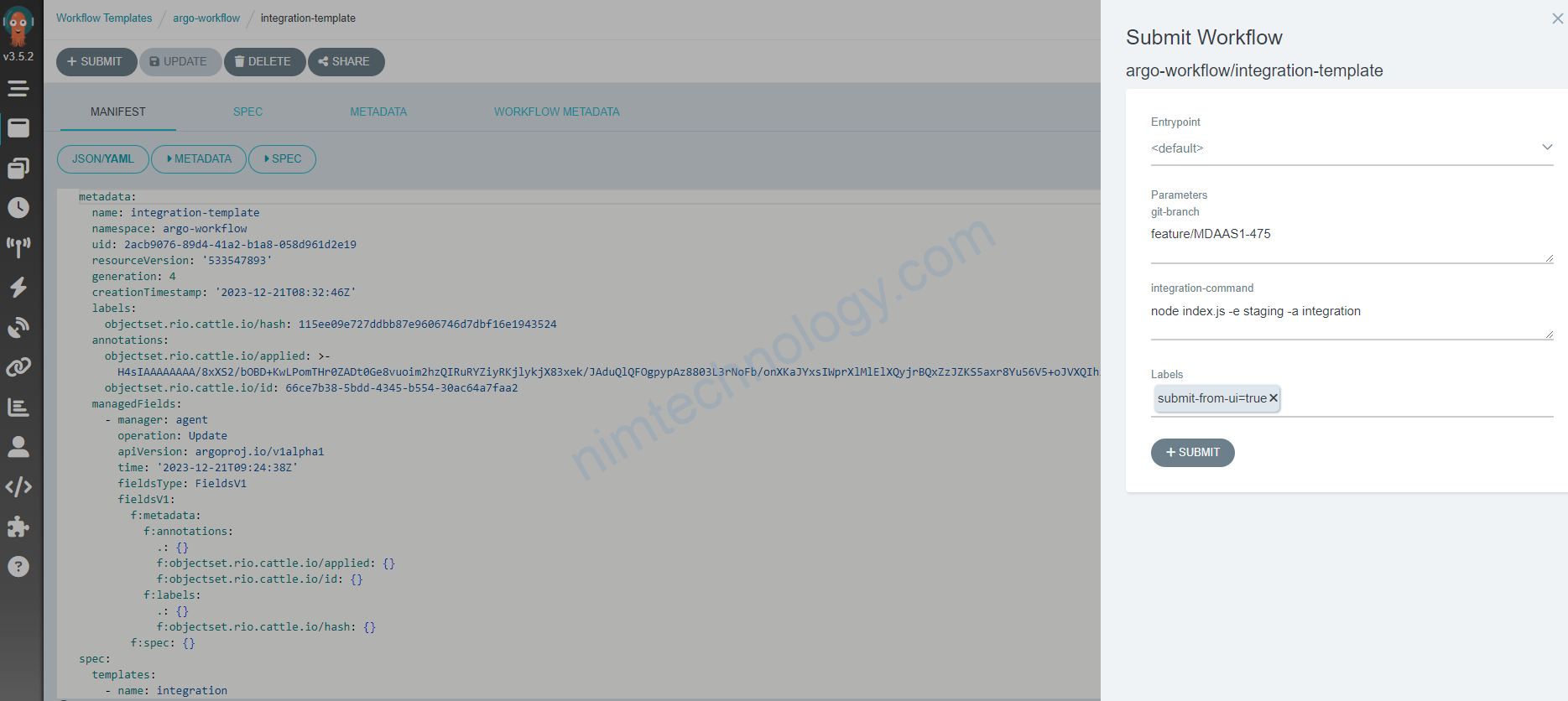
Để hiểu được vấn đề này chúng ta cần xem bài.
https://nimtechnology.com/2022/01/06/argo-workflows-lesson3-argo-cli-and-input-parameters/#Input_Parameters
Issues
You need to find the rool or clusterRole then update:
apiVersion: rbac.authorization.k8s.io/v1 kind: Role metadata: namespace: argo-workflow name: workflow-task-results-role rules: - apiGroups: ["argoproj.io"] resources: ["workflowtaskresults"] verbs: ["create"]
